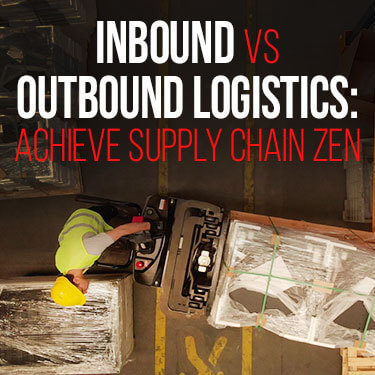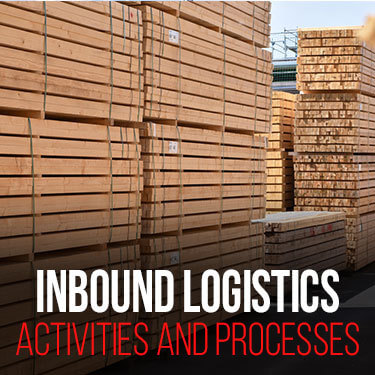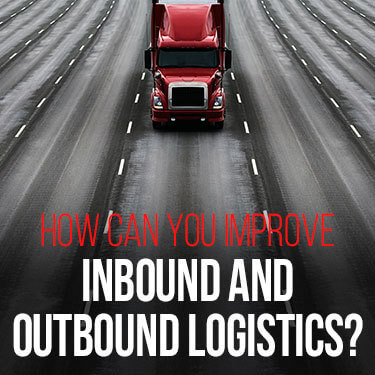
 Copy URL to Clipboard
Copy URL to Clipboard
Inbound vs outbound logistics can be thought of as opposite ends of two chains. The lock holding the two chains together is your business. Rather than competing, they are different stages of customer fulfillment. Your business is the hub that connects customers with goods. R+L Global Logistics is here to help you make sure that the chain has no weak links.
Inbound and outbound logistics processes span a business’ entire supply chain from source to consumer. Product sourcing and inventory management often make up the inbound logistics. Consumer services like packing and delivery are the backbone of outbound logistics. Efficiency in the entire process is necessary for success.
Explore the different aspects of inbound and outbound logistics to find the right solutions for your business supply chain as a whole.
Table of Contents
In many ways, inbound and outbound logistics represent a product’s journey from inception to consumption. They aren’t part of a circular cycle - as a business owner, you are probably trying to reduce the number of items that make their way back in the form of returns.
Let’s quickly define the two terms.
Inbound logistics refers to the methods by which products and goods get to a business. If a business sells hand-poured candles, then the inbound logistics may include paraffin, glass jars, and wicks needed for their manufacture.
Outbound logistics refers to the methods by which products leave a business to go to a consumer or retail center. In the case of the candle business, it could be packing materials and shipping services.
The specific logistics for either outbound or inbound needs will also be affected by the type of business and the customer base. Logistics for a B2B versus a B2C market will differ because their final mile services are likely to be very different.
Additionally, the processes and methods for organizing your inbound logistics might not work on the outbound side.
Want to know more? Check out our article on procurement vs logistics.

Inbound logistics activities will include every part of obtaining materials to put together a product for customers, whether those customers are individuals or other businesses.
Your own production, manufacturing, or warehouse capabilities will greatly impact your inbound logistics without being considered a direct part of it. If you are manufacturing products from raw materials, you want to make sure that your input isn’t overwhelming your production capabilities.
Perhaps you have an eCommerce business and your focus is on buying wholesale. If you are selling products in the fashion industry, you want to gauge whether you will be able to sell enough trending items before they go out of style. If not, you could get stuck with a warehouse full of outdated fashion trends.
Let’s take inbound logistics step by step for a better understanding.
Whether you are buying an already finished product or raw materials for manufacture, you need to carefully vet your supplier. Going with the best price isn’t always the best solution. You need to choose a supplier based on multiple parts of the inbound logistics process.
Before making your final selection, ask yourself a few questions.
With any business purchase, especially if you are just starting out, there is a considerable risk. Minimize those risks by choosing reliable suppliers who can provide a steady influx of what you may need when you need it.
Once you have, we get to the next step of inbound logistics.
This is the stage in the process where ease of ordering and price play a large role. If you are placing an order for something that must be shipped internationally, there are customs duties to plan for.
For components with a limited shelf-life, be sure to not order more than what you can process. If you are purchasing wholesale and plan on re-selling, look into what discounts you may get by buying in bulk.
For information on order planning, check out our article, “What is Demand Planning?”
Now things are really getting moving. Transportation services for inbound logistics can cover a variety of different aspects. As mentioned, this may even include getting your source material from overseas or across land-based borders - such as from Canada or Mexico.
Some of the routes your inbound logistics service should account for include:
Modern supply chain management struggles might be impacting the transportation aspect of business more than any other. Between labor shortages and rising gas prices, not to mention the multi-step approach that freight companies may need to take, make this part both expensive and stressful.
At this stage of the process, it’s best to work with a qualified 3PL that can manage transportation and the next stage of inbound logistics: receiving. A third-party logistics (3PL) company will often have access to a vast network of transportation services and be able to negotiate contracts for all parts of the process on your behalf.
Long term, this is likely to save you money because the contracts will be unified. If you are using the same 3PL for other parts of your business, like warehousing or inventory management, tracking your incoming items will also be easier.
This somewhat final step of inbound logistics involves actually taking ownership of incoming items. At this stage, the inbound process is complete, though some might argue that the actual inventory management process is also part of inbound logistics.
In any case, you want to be sure that you have a place to receive your ordered goods. This is where your outbound logistics may interact directly with the inbound aspects.
To make sure you have space to receive new items, you need to have sold and/or moved whatever was taking up space beforehand. These may be finished goods or raw materials for manufacturing the product.
Either way, you need to have a system in place for receiving, confirming, and storing items that come in. As mentioned, a 3PL service can greatly help with this process. If you are using the warehouse management services (WMS) of a 3PL, it is highly likely that all your items are being processed and cataloged as they come in.
If you are using a 3PL contracted warehouse, the unloading procedures are well thought out and may minimize damage to incoming items. For raw materials that need to undergo a manufacturing process, it may look a bit different.
Be sure that the facilities receiving your raw materials are using them appropriately in the manufacturing process. In most cases, this means having a system organized in a First In, First Out (FIFO) method. This is to ensure that raw materials aren’t going bad. It also provides a way to guide your ordering habits and track usage to prevent over-ordering on the next go around.

Outbound logistics processes begin once customers have placed their orders. Once again, these processes may be carried out differently depending on your customer base. Selling to another business may have very different requirements than selling to an individual.
Many aspects of outbound logistics can also be handled with an efficient Order Management System (OMS).
Once again, let’s break down the specific activities and processes of outbound logistics.
There are a significant amount of details that go into play when a customer places an order. All of those details may impact the other parts of outbound processes. Assuming this is an order that is meant for delivery, consider these details.
The impact of some or all of these items will vary based on the business model you use. For instance, you may not offer specific time frames for products or you may have a limited number of shipping options available.
Part of running a business successfully is finding the balance between customer satisfaction and realistic order fulfillment. Don’t promise next-day delivery if you can’t guarantee it or if making it available to the customer would make products prohibitively expensive.
Before products can be picked and packed for delivery, this step ensures the items will actually be available. On the consumer’s end, this step might happen instantly. They go to select an item from your site only to be informed that a particular item is out of stock. Simple enough.
On the business side of the equation, that simple task required some sophisticated outbound logistics to pull off.
An OMS or WMS (perhaps both working together) is needed to have real-time access to current inventory. That system needed to be connected to the website where the purchase could be made. If there were only one item left, and two people clicked on it five minutes apart, the system needed to know which selected it first and then transmit that piece of information to inventory management.
At the end of the day, transmission and processing are unsung heroes in outbound logistics. As eCommerce industries and web ordering become the norm, the people working on these digital programs have to account for more and more variables.
In some cases, these processes could be actively running across multiple sales platforms, including web, social, and brick-and-mortar stores, known as omnichannel management.
Once it's been determined that you have the ordered products available, in both the style and quantity requested by the customer, it's time to begin packaging. Bulk orders are likely the easiest to fulfill in terms of complexity.
In the case of a B2B transaction, perhaps you manufacture coffee mugs in a few different colors. A cafe puts in an order for 100 black coffee mugs. Fulfilling the order is simple because every item is the same product and style.
For more individualized orders, which B2C business models work with, you need a specific pick & pack method for order fulfillment that ensures both speed and accuracy.
There are different methods depending on warehouse setup and individual needs.
Whichever method you choose, it's important to recognize where errors may occur and try to avoid them. Correct product selection will also go a long way toward reducing the rate of returns because of mistaken products.
More information on using pick & pack services wisely can be found in our article, “How to Reduce Picking and Packing Errors”.
The order has been picked, you know where it needs to go. Now, you just have to get it there. Depending on the size of the orders, you may not be able to use the same transport services you contracted for your inbound logistics needs.
Again, much of this will depend on your product and customer base. A B2B is more likely to need a carrier with freight capabilities for outbound logistics than a B2C business is.
Your inbound transport likely required a carrier that moved freight specifically - orders above 150 pounds. Depending on the size and scope of materials, you may have even had things delivered through Full Truckload (FTL) services. For smaller individual deliveries, you can hardly send a full-sized trailer to every house for a single package.
There are a few different distribution channels to handle smaller final mile delivery services.
Not every transport method will grant you the same amount of control over your services. If you want to include reverse logistics (returns) as part of your transportation services, it's another factor to be accounted for.
It's important to be aware of the average time each type of delivery service might take. Being upfront about these times with customers helps create a good relationship. Even if a shipment takes a month to arrive - so long as you told the customer from the start, studies show they are surprisingly okay with it.
| Method | Average Time from Order to Fulfillment |
| Parcel Post | 2 - 14 days |
| Distribution Center | 1 - 35 days |
| Amazon FBA | 3 - 5 days |
| Dropshipping | 12 - 60 days |
Recognize that these are estimates based on standard delivery, not expedited or next-day options. These will also depend on whether or not a product needs to undergo manufacturing or customization after being ordered, such as a made-to-order bridesmaid dress.
Don’t feel that once you have chosen a method for transport and delivery you will be stuck with it all of the time. You may have to test out a few different options before finding one that meets your needs and falls within the scope of your business plan.
After having reviewed in-depth what services are considered inbound or outbound logistics, it's good to see the whole process laid out.
| Inbound Logistics | Outbound Logistics |
| 1. Sourcing and Suppliers | 1. Customer Orders |
| 2. Order Placement and Purchase | 2. Transmission and Processing |
| 3. Transportation | 3. Product Selection |
| 4. Receiving | 4. Transport and Customer Delivery |
The two halves may have some aspects in common, such as transportation, but the ultimate needs connected to each task will be different.

Business logistics are ever-evolving, and not always for the better. Market changes can make any or all of the steps involved in inbound and outbound logistics more challenging to carry out.
Avoid thinking of inbound logistics versus outbound logistics as though there were in competition with each other. In the end, they are both vital parts of the supply chain keeping your business running. Each link in that chain needs to be examined for weak points.
Start by knowing where your trouble spots are going to be. Any problem will eventually impact your customer service but some will do so more than others. Since your customers are what keep you in business, manage these issues with care.
The good news is that all of these challenges can be overcome with patience, attention to detail, and plenty of hard work.
Improving your inbound and outbound logistics isn’t a one-time deal. There are factors big and small that will impact both sides of the equation.
The last point is especially important - as the saying goes, numbers don’t lie. Analyzing your data regularly can reveal trends in either direction, provide insight into spending practices, and alert you of sudden deviations from the norm.
Successful logistics planning is within your reach. R+L Global Logistics has been a trusted 3PL partner for many years and we know how to lend a hand in outbound logistics and beyond.
We have trusted partners who can assist you with warehousing, fulfillment, and distribution of products from central locations around the country.
Need help getting materials moving across the country? Check out our contacts for dross docking and transload services.
Call today at (866) 989 - 3082 to speak with an experienced and knowledgeable representative or get a direct services quote and begin improving your logistic services today.
